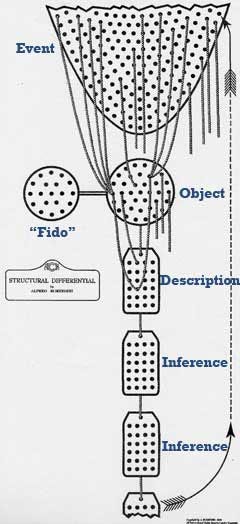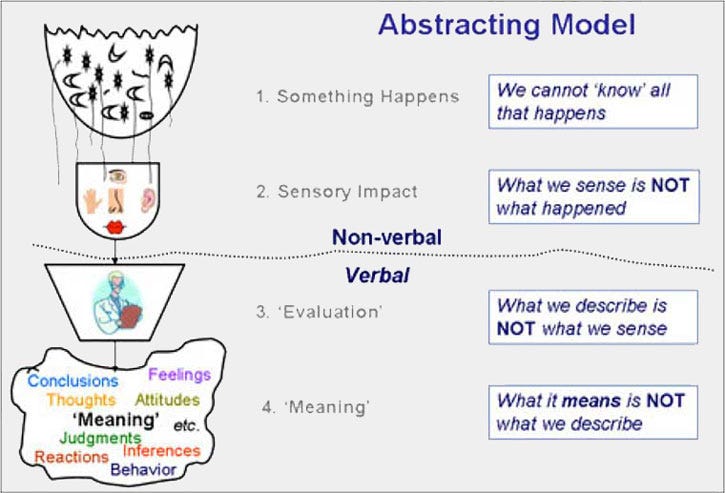Abstracting, in the context of Korzybski’s model, refers to physio-neurological processes that occur on non-verbal and verbal levels. From the world of energy stimulations that envelope us, our nervous systems abstract (or select, choose, pay attention to, etc.) only a fraction. From these partial, incomplete, and fleeting sensations, the nervous system must construct our conscious or aware experiences by matching patterns of stimuli with the brain’s ‘database’ of previous experiences.
Abstraction process: Structural Differential

Alfred Korzybski developed this diagram in the 1920’s as a means to visualize the abstracting process. The parabola represents an environment (the world around us) consisting of innumerable characteristics or events. Only some of these characteristics can be detected by human senses. These initial sensory data are further abstracted and transformed as the nervous system/brain recognizes and associates the data with a word or label. The tag below the circle represents the Descriptive (verbal) level of abstracting.
From descriptions of events we form inferences, assumptions, opinions, beliefs, etc., by generalizing this experience with our past experiences. And we can continue, indefinitely, to forming ferences from inferences,. which may then be subsequently recalled in future experiences.
Abstracting
Something happens (Event);
I sense what happens (Object);
I recognize what happens (Description);
I generate meanings for what happens. (Inferences)

The process of abstracting involves four main steps. The first step is that something happens, which could be an event or a series of events that occur in the world around us. The second step is that we sense what happens, which means that we perceive it through our senses such as seeing, hearing, feeling, or smelling.
Once we sense what happens, the third step is that we recognize what happens. This means that we give a description or label to what we have sensed, in order to understand and make sense of it. For example, if we see a red apple, we recognize that it is an apple, and we describe it as being red in color.
The final step in the process of abstracting is to generate meanings for what happens. This involves making inferences, which are interpretations or conclusions that we draw based on our understanding of what happened. Inferences are often based on our prior knowledge, beliefs, and experiences, and they help us to create meaning and make sense of the world around us.
Overall, abstracting is a cognitive process that helps us to understand and make meaning of the world around us, by sensing, recognizing, and generating meanings for the events that occur.
Abstracting refers to ongoing physio-neurological processes that occur on non-verbal levels. EVENT is not OBJECT is not DESCRIPTION is not INFERENCE, etc. We can verbally differentiate certain phases, or levels or orders, of the abstracting process to analyze our behaviors and reactions. What we experience is a function of the unique capabilities and limitations of our own individual nervous system.